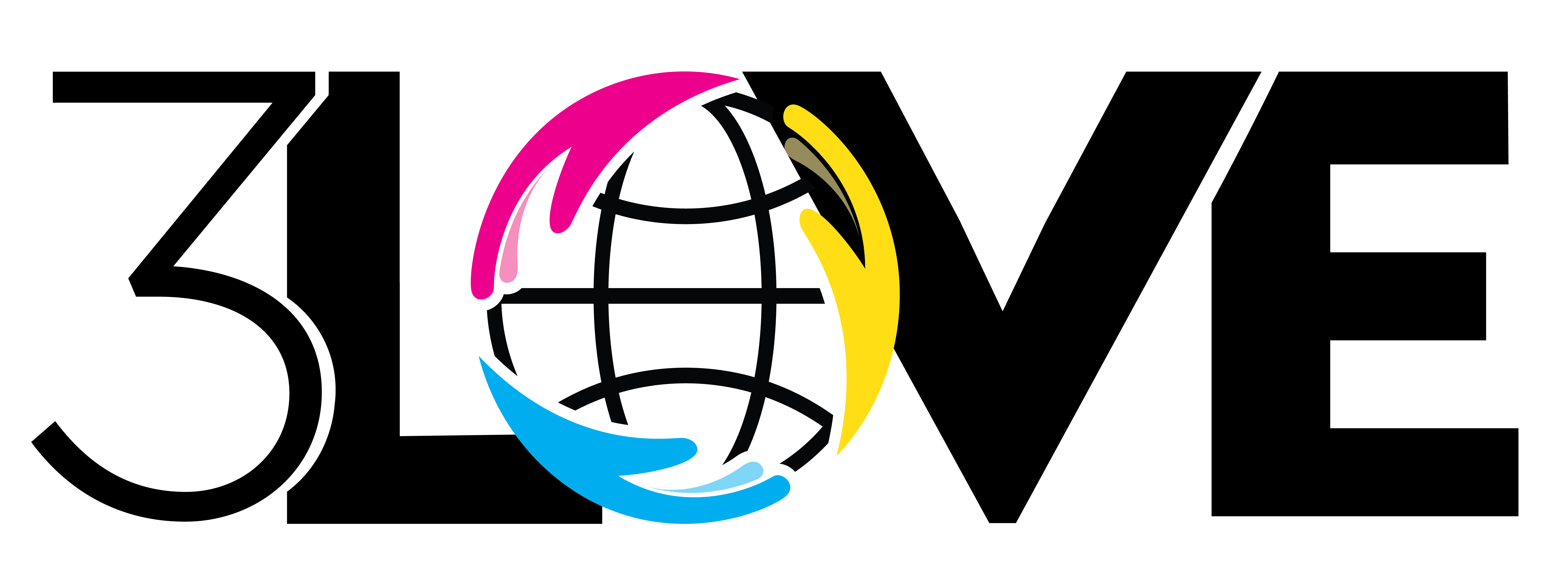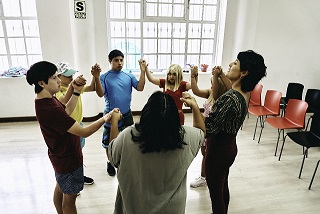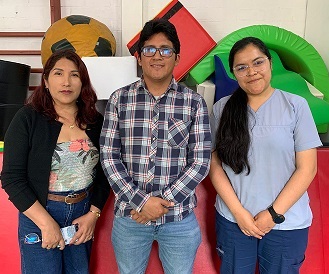Nea Ampuero is a communicator and multidisciplinary artist with experience as a clown and performer. She uses clowning for “artivism” (art + activism) to work collectively, promoting social, eco-friendly, and community projects that transform the world through love and play. In this interview for the 3Love Inc. blog, we talk with Nea about her experience teaching clown workshops for deaf people and people with Down syndrome, the challenges and rewards of creating art with people with disabilities, the skills that clowning allows us to develop, and the importance of arts education for children and adults.
You define yourself as an “artivist,” which is a combination of the words art and activism. What does it mean to be an “artivist”?
Thank you for this opportunity. For me, being an “artivist” means being an active agent in society, that is, being able to create and generate critical thinking and reflections on specific issues: how society is constructed, global justice, environmental issues, inequalities, etc. For me, these artistic expressions and clowning as a comic language help me to express questions, generate spaces for dialogue and inquiry, but through comedy or what clowning has to offer and what I believe my character can convey with tenderness and mischief in order to express a discourse.
You recently taught a clown workshop for boys and girls with Down syndrome at Capaz Peru. Tell us about how this experience was for the students.
I have been working with Capaz, supporting them in communications and also in the artistic area, in line with Capaz’s methodology of providing or creating a space that adapts to different types of possibilities. Along with this methodology, I bring clowning, which for me is a universal tool because we are talking about playing. I had previously had experience doing theater games with young people with Down syndrome in the Aliados group alongside two art teachers, but this time my challenge was to do it alone with these participants, who are between 16 and 26 years old. There were six students: four men and two women. I have experience teaching clowning and play workshops, but for me it was a challenge, above all, to be able to modify and adapt the rhythm of clowning or play, understanding the possibilities that each person with Down syndrome had, because each one is unique. In clowning, there is a tool called active listening, which allows you to transform, play, and enjoy. So, it was necessary to adjust that listening rhythm or time frame to receive the message. Another important thing was to talk directly with the parents and even with the students, because I feel that many of them had prejudices. It is always said that clowns laugh at themselves. Many of them have suffered bullying in their schools. So, I had to give them this speech: “You’re not making a fool of yourself so that others will make fun of you, but on the contrary, you’re laughing at yourself and accepting it.” I think that was also one of the most important parts, that they could receive that message, each in their own way, and especially their mothers and fathers. For example, there was a student named Mateo, who always likes to talk about Santa Claus and always says “Ho ho ho,” even in dramatic scenes he had done before. But this time, since it was summer, I said to him, “Imagine we do a scene with Santa Claus in summer and his ice cream melts.” In other words, it’s about taking these particularities that each human being has and being able to incorporate them into the game, even in an improvisational scene. For me, that experience was obviously very enriching. It was a lot of fun because everyone left laughing and eager to play. The parents commented that the kids left class very hyperactive, but that was also the purpose. And I would like to add that I also had the experience of teaching clowning to deaf people.
How was that experience?
It was something that just happened; I didn’t plan it. I started a workshop with the cultural association Trenzar. A girl I met through Capaz found out that I was doing this workshop, and she is deaf. She asked me, “Can I come?” And I said, “Yes, of course, but I only know the basics of sign language.” And she said, “I can bring a friend who can interpret.” And I said, “But I really didn’t design this course for deaf people.” And she said, “I know you, I trust you, and there are no other spaces within the art scene.” That was one of the things that also opened our eyes and broadened our horizons in general. She came one day and the next day she came with another friend who is deaf. So, in the end I stayed with the two of them and the interpreter. There were about 14 of us in the workshop, and this was a truly diverse group, because there were hearing and non-hearing people. In the class, apart from providing them with a language of play, this clown had an activist discourse, because the workshop was called “Clown in Risastencia” (Clown in Laughter and Resistence). It was about showing hearing people and non-hearing people these compatibilities that art or clowning could also open up if it was inclusive. For the hearing students, it was a learning experience. And I also discovered the abilities of deaf people with physical humor. The exercises were adapted for both hearing and non-hearing people. As we say at Capaz: “Yes, we can”: yes, we can do theater, and yes, we can perform plays with hearing people and non-hearing people. Art has that ability to bring everyone together.
What was the most important lesson you learned from working with people with disabilities?
I think the most important lesson for me, as a person, was tolerance and knowing that we are all capable. And as a professional, it was being able to broaden my sphere of dynamics or teachings so that culture or art is more accessible from the course design. And to be able to accept the results as well, because every artist or teacher always has that drive to want to be better, to want to achieve the result. So, you have to be very accepting and tolerant when working with people with disabilities; you have to believe and trust.
What kind of skills does clowning allow people to develop?
Depending on your approach, clowning can be used as a communication tool, either to develop soft skills or to raise your voice. Clowning has a quality of vulnerability, of exposing yourself, so I think it’s about facing yourself. Clowning brings out the most beautiful things you have, as well as the unknown or what you sometimes hide. Through play and vulnerability, you show that and you can enjoy it or find a lot of pleasure in it. So, I think it’s a tool for communication and self-knowledge. And it’s also a craft, that is, it’s a practice where you can create artistic numbers, improvisations, you can be on stage or on the street. I think clowning can be seen as something minor, but in reality, clowns do many things that you can’t do on your own.
You have experience as a teacher of clowning, theater games, and art-related activities. Why is it important to promote arts education from childhood?
Because I believe it is part of the vital energy needed to coexist with all people, animals, and the environment. It is an important ingredient that helps strengthen and sensitize your human side so that you can continue to connect with other people, respecting, listening, embracing, or denouncing. It gives you that openness to also discover many of your inner facets or spheres. And within education, it is key to the formation of childhood, because we live in structures that sometimes fit us into a specific way of thinking, but I believe that arts education gives you that break or respite and at the same time helps you to build your own way of thinking, your own way of living.
What does learning different artistic disciplines generate in both children and adults?
I believe it generates pleasure and the ability to enjoy what one is doing in the present, to feel pride in oneself when one accomplishes something, to get to know oneself better, because when one approaches art, I believe many things are activated on a mental, emotional, spiritual, and physical level. Any type of art helps one connect with oneself and with others.
From a teacher’s point of view, what is the greatest satisfaction you get from teaching clowning, theater, and art to other people?
I believe that happiness is fleeting, but there is a moment of ecstasy, so to speak, where that exact moment comes together when you feel happy and fulfilled with yourself and with everything, and that is reflected in your eyes or in your smile or in your tears. That little moment is the manifestation that something happened, and it’s like the little plant inside was watered, like something emerged. I like it when a transformation is generated, either inside or outside. And clowning has that ability.
What would you say to people with disabilities who are interested in clowning or other performing arts but haven’t yet had the opportunity to try it? What would you say to motivate them to give it a go?
It depends a lot on external conditions and the possibilities of each person who wants to get involved in the arts, whether it’s where they live, their family environment, their customs, or their education. But if they have this awakening or this impulse, then they should look for the possibilities that exist and, at the same time, demand that spaces be opened up. In Lima, we have Capaz, an association in which, either self-managed or with allies from different artistic institutions, spaces are being created for more people. So, I think they should listen to their hearts and trust in their autonomy to tell their companions or their parents: “I want this.” Above all, they should see theater performances, art, dance, etc. I believe that this is a primary approach to learning that there are many things out there and that Peru is a very diverse country. I met a child with autism who watched videos on YouTube and made sculptures with modeling clay and created his own channel. A teacher saw him on the internet and said, “Hey, I can teach you more.” So, I think it can also be self-taught. And that they follow their hearts and that no barrier keeps them in their comfort zone.


